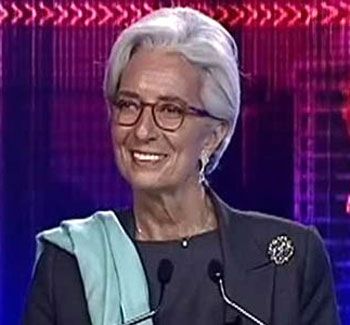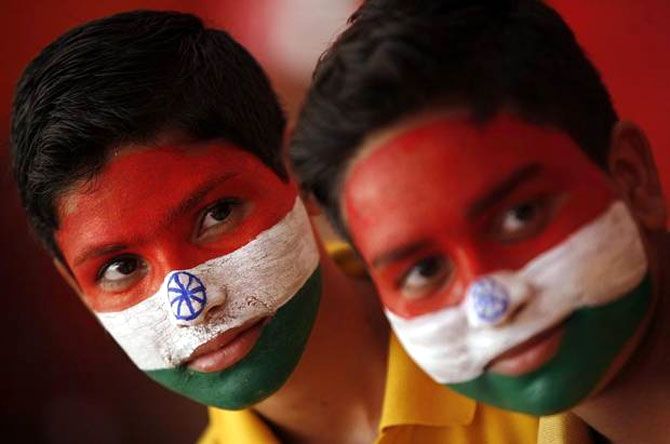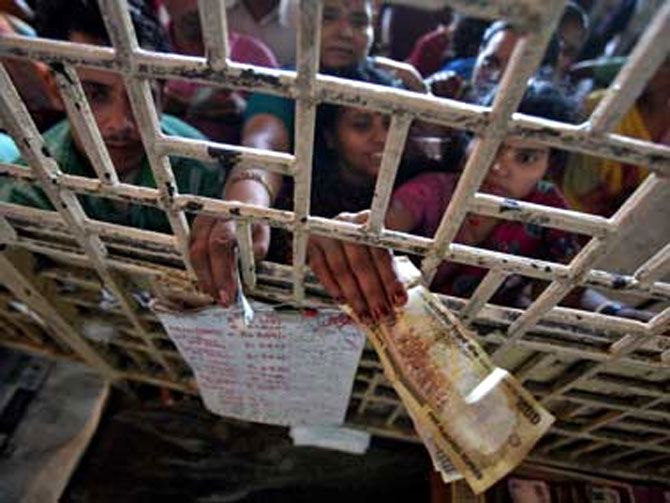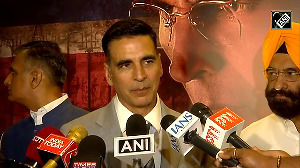The elements are all aligned to make India a global powerhouse, says IMF Managing Director Christine Lagarde.
 Good afternoon -- Namaste!
Good afternoon -- Namaste!
Dear faculty members, students, and distinguished guests, thank you for having me here today.
It is a pleasure to be back in India and speaking at such a prestigious academic institution. Your mission is to prepare young women to assume leadership positions and to develop critical thinkers and concerned citizens. I cannot tell you how much I support this important mission. And on a personal note, I am especially pleased to be invited by the center named after an alumna of this school, and a woman I admire greatly -- Aung San Suu Kyi.
I also find Lady Shri Ram’s philosophy appealing -- the belief in a “holistic” vision that “never discounts the past while embracing the future with unwavering confidence in its ability to shape it and harness its potential.” Unwavering confidence! Amid all the anxiety that we face when thinking about the future these days, it is good to be reminded by the teachings of past history that we have the power to shape this future; and yes, there is so much to look forward to!
It is through this prism that the world, IMF included, sees India today. A rich and complex culture and a vibrant society, India is more than just India -- it is more than the sum of its parts, intimately connected with the world. It has become a leader in information technology, sciences, pharmaceuticals, biotechnology, you name it, with many home-grown experts working in multiple companies around the world. And not only has India managed to find the most cost-effective way to send a mission to Mars, it also gave us Yoga, Ayurveda, Bollywood, and Chicken Tikka Masala!
The Gitanjali poem by Rabindranath Tagore embodies where India is:
‘Where the mind is without fear and the head is held high;
Where knowledge is free;
Where the world has not been broken up into fragments by narrow domestic walls…’
Here is your country. This is a special moment for India. Just as many countries around the world are grappling with low growth, India has been marching in the opposite direction. This year already, India’s growth rate is expected to exceed that of China, and by 2030, it is will overtake China as the most populous country in the world.

The conditions are ripe for India to reap the demographic dividend and become a key engine for global growth. It is on the verge of a new chapter, filled with immense promise. You young women and men here in this audience will shape India’s destiny, and indeed the destiny of the world. So let me propose how your energy and vitality can shape and serve a better tomorrow.
(i) We will take a tour of the global economy, and explore how we can inject greater momentum.
(ii) And I will share my views on India’s economy and consider if it is ready to fly higher?
(iii) And then, I will talk about the quality of growth and how it can benefit the poor, the women, and the youth of India.
1. State of the global economy -- injecting greater momentum
Let’s start with the state of the global economy. More than six years after the global financial crisis, the recovery remains too slow, too brittle, and too lopsided. We have pared down our forecasts of global growth since last October, despite the boost from cheaper oil and stronger US growth. And while the global economy is expected to grow by 3.5 percent this year, and 3.7 percent next year, this is still below what could have been expected after such a crisis.

In most advanced economies, prospects continue to be weighed down by the “high-high, low-low” legacies of the crisis -- high debt, high unemployment, and low growth, low inflation.
Too many firms and households keep cutting back on investment and consumption today because they are concerned about low growth in the future.
Apart from the United States and the United Kingdom, where a promising recovery continues, growth remains rather low in the Euro Area and Japan. But one sees some reassuring “pick up signs.”
Momentum is slowing in many large emerging market economies. China is decelerating to a more sustainable growth rate, whereas Russia and Brazil, albeit for different reasons, find themselves in recession territory.
Looking ahead, something better may yet come on the back of low oil prices and low interest rates. Still, there are significant risks to this fragile global recovery.
The first risk is what I have called “asynchronous monetary policy” in advanced economies -- normalising monetary policy in the United States and the United Kingdom while Japan and the Euro Area are increasing monetary stimulus. Even if this process is well managed, it may result in excessive volatility in financial markets, including in India.
The second risk is that the Euro Area and Japan could remain stuck in a “low growth-low inflation” gear for a prolonged period. This would make it harder for countries to reduce unemployment and excessive public and private debt, and raise the risk of recession and deflationary pressures around the globe.
The third risk is that emerging and developing economies could face a triple hit of a stronger US dollar, higher global interest rates, and more volatile capital flows. A stronger dollar will have a significant impact on financial systems in emerging markets, including India, because many banks and companies have increased their borrowing in dollars over the past five years.
Of course, compounding these risks are geopolitical tensions that are simmering in different parts of the world.
All this points to one thing -- coordinated policies and renewed momentum into the global economy. In practice, this means accommodative monetary policies where appropriate, growth- and job-friendly fiscal adjustment, and above all, much needed structural reforms that are critical to lift employment and growth in countries all over the world.
For example, the drop in oil prices provides a golden opportunity to cut energy subsidies -- which generally favour the middle class -- and use the savings for more targeted cash transfer systems to protect the poor. This is a policy that the IMF has been pushing very hard, and where India has made important strides. Through the Aadhar system, some fuel subsidies are now being replaced with cash transfers to the poor.
All this is not new. But it has taken on new urgency. And this places increased emphasis on political leadership.
2. India tomorrow -- ready to fly?
So where is India in this global configuration?
In this cloudy global horizon, India is a bright spot. Recent policy reforms and improved business confidence have provided a booster shot to economic activity. Using India’s new GDP series, the IMF expects growth to pick up to 7.2 percent this fiscal year and accelerate further to 7.5 percent next year -- making India the fastest growing large economy in the world.
Indeed, a brighter future is being forged right before your eyes. By 2019, the economy will more than double in size compared to 2009. When adjusting for differences in purchase prices between economies, India’s GDP will exceed that of Japan and Germany combined. Indian output will also exceed the combined output of the three next largest emerging market economies -- Russia, Brazil, and Indonesia. So clearly India’s weight among the group of emerging markets will increase.
Much of this has to do with population growth. More than 50 percent of India’s population is currently below the age of 25, and more than 12 million people enter the labour market every year.
By 2030, India is expected to have the largest labour force in the world. At more than one billion people of working age, India’s labour force will be larger than the combined labour force in the United States, the Euro Area, and Indonesia. The potential benefits to be reaped from your collective work efforts could be enormous.

So we know India can run -- judging by your cricket record! Can it fly? I believe it can. As India grows and takes its rightful place in the global economy, the focus should remain on sound policies and inclusive institutions.
This is where stronger economic frameworks come in -- to make the economy more resilient, nimble, and ever more supportive of growth.
Let’s start with fiscal policy. A sound, growth-friendly revenue and expenditure framework anchored in an explicit medium-term consolidation path is critical. The recently approved Budget is a step in the right direction and contains several promising elements. For example, the emphasis on increasing spending to upgrade India’s infrastructure is critical -- a point to which I will return later.
Looking ahead, progress on other measures can help underpin the consolidation effort, such as further subsidy reform and implementation of the goods and services tax.
How about monetary policy? Here too, a sound monetary policy framework to keep inflation under control and ensure financial stability is essential. India’s recent adoption of flexible inflation targeting is indeed very welcome. This framework should provide a robust institutional foundation for maintaining price stability as growth is picking up.
Finally, a sound and healthy financial sector is essential to support strong and sustainable growth. This requires banks, including public sector banks, with strong balance sheets.
Higher capital injections and improved operational efficiency can certainly help in strengthening banks’ balance sheets. But there can also be synergies between fiscal consolidation and financial intermediation. As the fiscal deficit continues to shrink, Indian banks can reorient their balance sheets away from holding government securities toward more lending to the private sector for investment and growth.
Still, international experience tells us that an ambitious growth rate cannot be a goal in itself. It should also support an increase in the well-being of the population and improve opportunities for those who have been traditionally excluded, so that they be included.
3. Making India’s growth more inclusive
This takes me to the last topic I want to discuss today -- how to make India’s growth more inclusive so that that it will be more sustainable.
(i) Unleashing the potential of women

Starting with the potential of women -- India faces some unique challenges. On the one hand, women have made great strides in society. You are all a good example of that. On the other hand, much remains to be done to give girls and women a level playing field in India; equal access to education and healthcare, and most importantly -- respect, so that all the daughters of India can feel safe in the cities and villages of your beautiful country.
I am very heartened by the prime minister’s campaign on saving the girl child and educating the girl child. Giving girls a level playing field is not just morally right -- it also makes economic sense.
Tapping the potential of women can be a game changer in many countries. India is no different. In fact, we have just released a study, ‘Women Workers in India: Why So Few Among So Many?’ that looks at female labour force participation issues in India. Here are a few numbers from that study:
• 33 percent -- this is India’s female labour force participation rate. This is lower than the global average of 50 percent and well below the East Asia average of 63 percent. This means that only 125 million of the 380 million working age Indian females are currently part of the labour force.
• 52 percent -- this is India’s gender participation gap (the difference between male and female labour force participation). It is one of the widest among the G-20 countries.
• Declining -- India’s female labour force participation rate has been on a declining trend since 2005, in contrast to most other regions.
These numbers represent a huge missed opportunity and should surely compete with an Indian victory in the Cricket World Cup as front-page news! Urgent remedies are needed!
A good starting point is to make Indian labour markets more flexible. Our study suggests a number of legal and institutional barriers that should be removed to facilitate entry of women to the labour market. This would also allow women to move from the informal sector (where they tend to be disproportionately employed) to the formal sector.
So today, I would like to call on all of you -- men and women -- to help your “sisters” to realise their full potential.
(ii) Increasing financial inclusion
Let me turn to the second priority -- financial inclusion; that is, reaching out to the “unbanked”.
Why is this important? Because financial inclusion is strongly rooted in empowerment. Access to credit is a key link between economic opportunity and economic outcome. By empowering individuals and families to cultivate economic opportunities, financial inclusion can be a powerful agent for strong and inclusive growth.
There is already a lot that the world can learn from India. The Economist’s Global Microscope ranks India very highly for creating an enabling financial environment.

This is not surprising. Under the prime minister’s Jan Dhan Yojana, financial services have been extended to more than 125 million previously unbanked individuals -- an impressive achievement in such a short span of time! And India also expanded basic insurance coverage so people’s lives become more secure.
What makes these achievements even more remarkable is that this financial inclusion approach is embedded in a broader strategy to use these accounts to provide cash transfers to those who need them. Programmes in other countries such as Mexico’s Prospera also capitalise on the link between financial inclusion and targeted transfers.
India can build on these steps and go further, for example, by increasing access of small and medium size enterprises to the formal financial system so as to boost investment and jobs growth.
(iii) Investing in infrastructure
The third and final priority is investing in infrastructure. What do I mean by that? I mean efficiently connecting people and markets domestically and globally. It means being both cyber-connected and highway-connected. I know you are all very connected on social media, but the same level of interaction is needed to connect you and other consumers to your country’s ports, shops, and factories!

“Make in India” and “Make for India” are very laudable objectives. But they require an open and competitive business environment to flourish, and they need reliable and affordable sources of energy, transportation, and communication.
India’s infrastructure needs are immense. By some estimates, an additional US$1 trillion in infrastructure investment is required over the medium-term. So while increasing public spending on infrastructure is a step in the right direction, more needs to be done to crowd in additional private investment. Resolving outstanding issues in public-private partnerships in infrastructure is critical in ensuring that India’s needs are addressed.
Many of these projects were delayed due to regulatory uncertainty and bureaucratic holdups. Much needs to be done in easing land acquisition, expediting clearances, and establishing a stable regulatory regime so that the private sector can invest. These issues are on the radar of policymakers, which is promising, they must be on the action list.
Conclusion
Let me conclude.
At the current juncture, the world needs a vibrant India and India needs the world! As one of the largest commodity importers in the world, an open and transparent multilateral system for trade and financial flows will be essential to support India’s vibrant economy. With growing economic size and power come greater leadership expectations. We look forward to seeing India becoming even more active on the global stage -- in fora such as the G-20 and the IMF.
The IMF is a global multilateral institution where countries like India deserve a bigger say. We are working precisely on that -- on implementing reforms that would lift India to the top 10 shareholders at the IMF.
I look at you and I recognise the massive potential of India’s huge pool of youth. I would also like to acknowledge the many talented Indian staff at the Fund and the contribution they have made over the years. Your very own central bank governor, Raghuram Rajan, was one of our most distinguished economic counselors!
There is an old Indian proverb that says: ‘Yesterday is but a dream, tomorrow but a vision. But today well lived makes every yesterday a dream of happiness, and every tomorrow a vision of hope. Look well, therefore, to this day.’
Today, the elements are all aligned to make India a global powerhouse. This is India’s moment. Seize it. Chak De India!
Thank you.
This is an excerpt from the speech Christine Lagarde made at the Lady Shri Ram College, New Delhi, on March 16, 2015.












 © 2025
© 2025